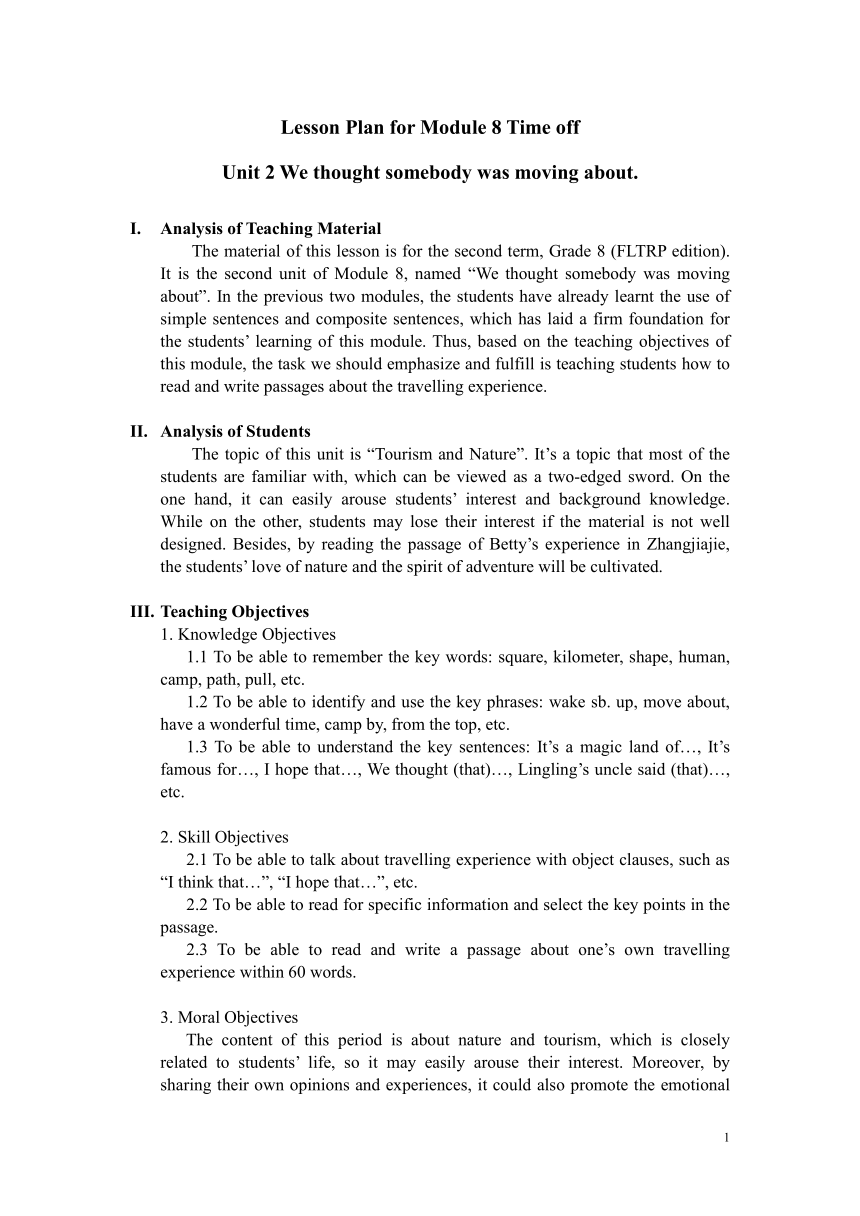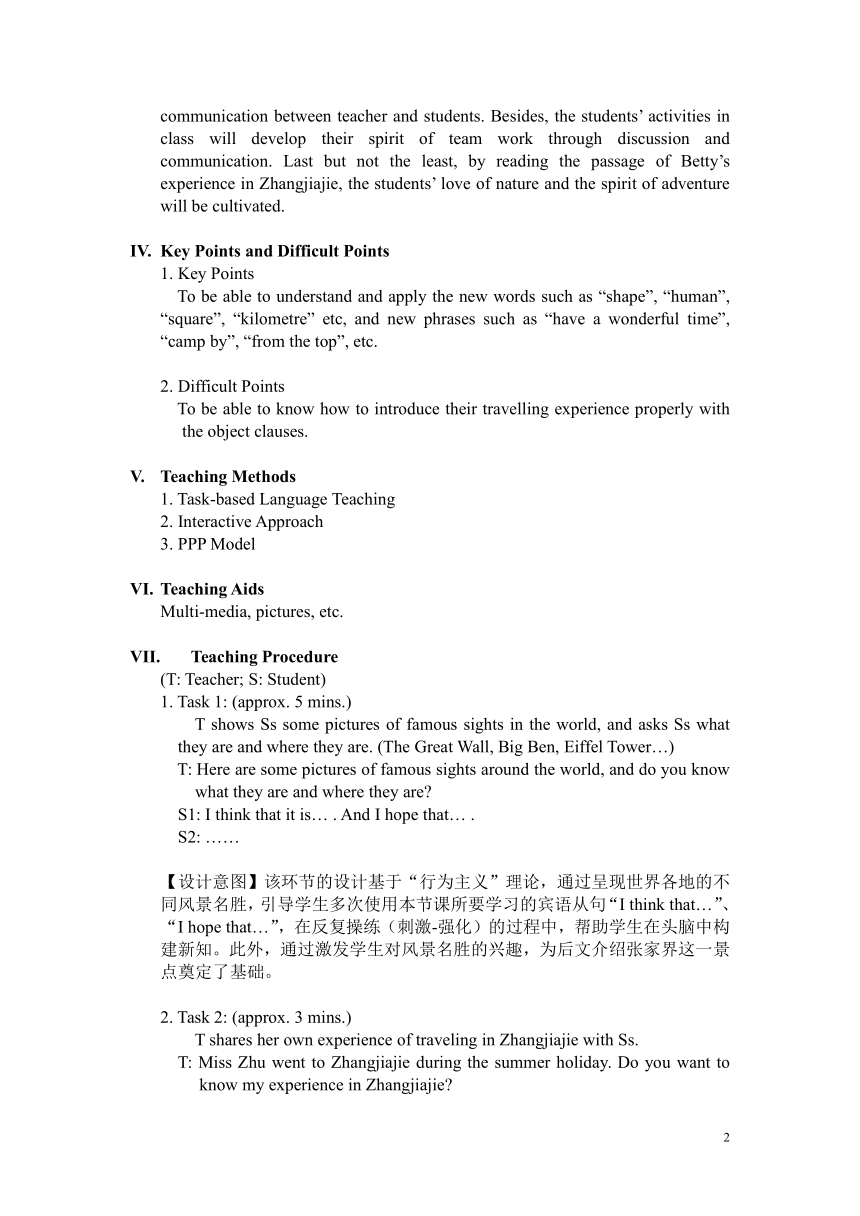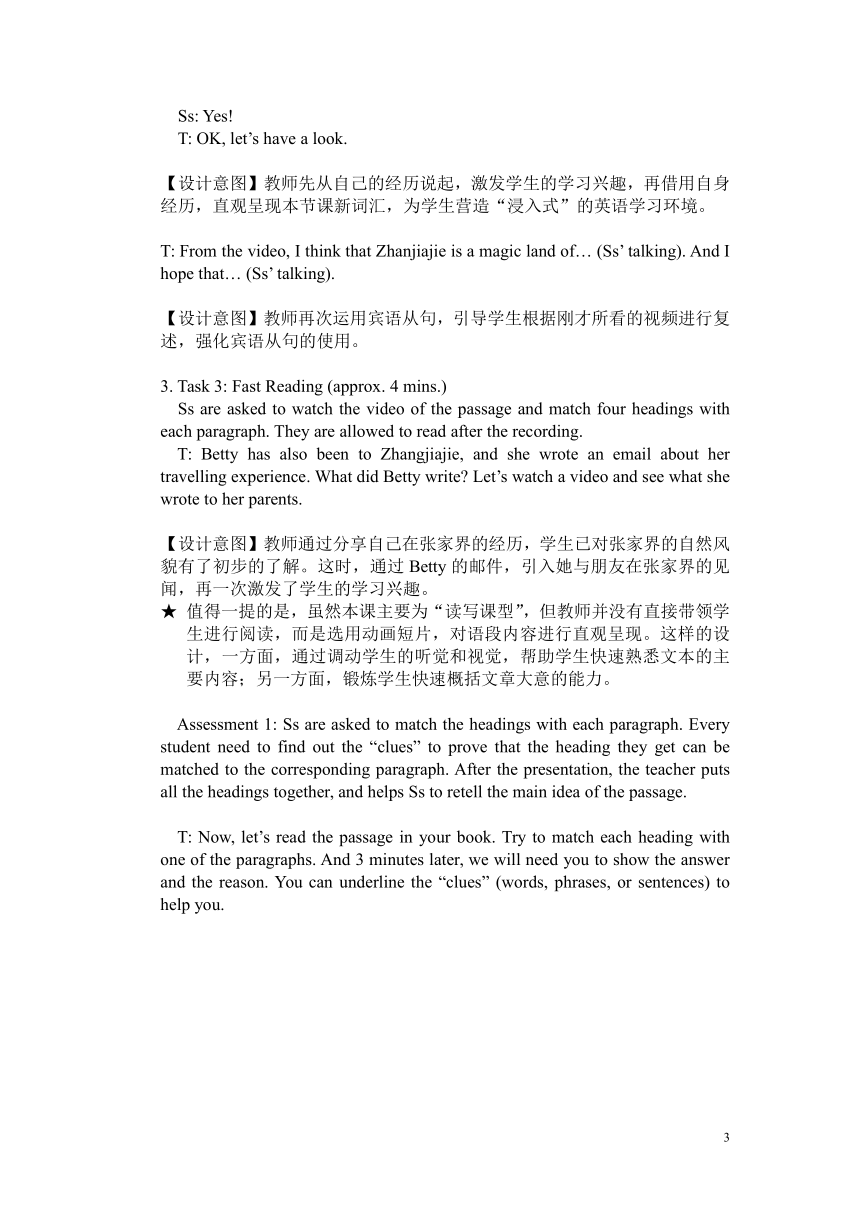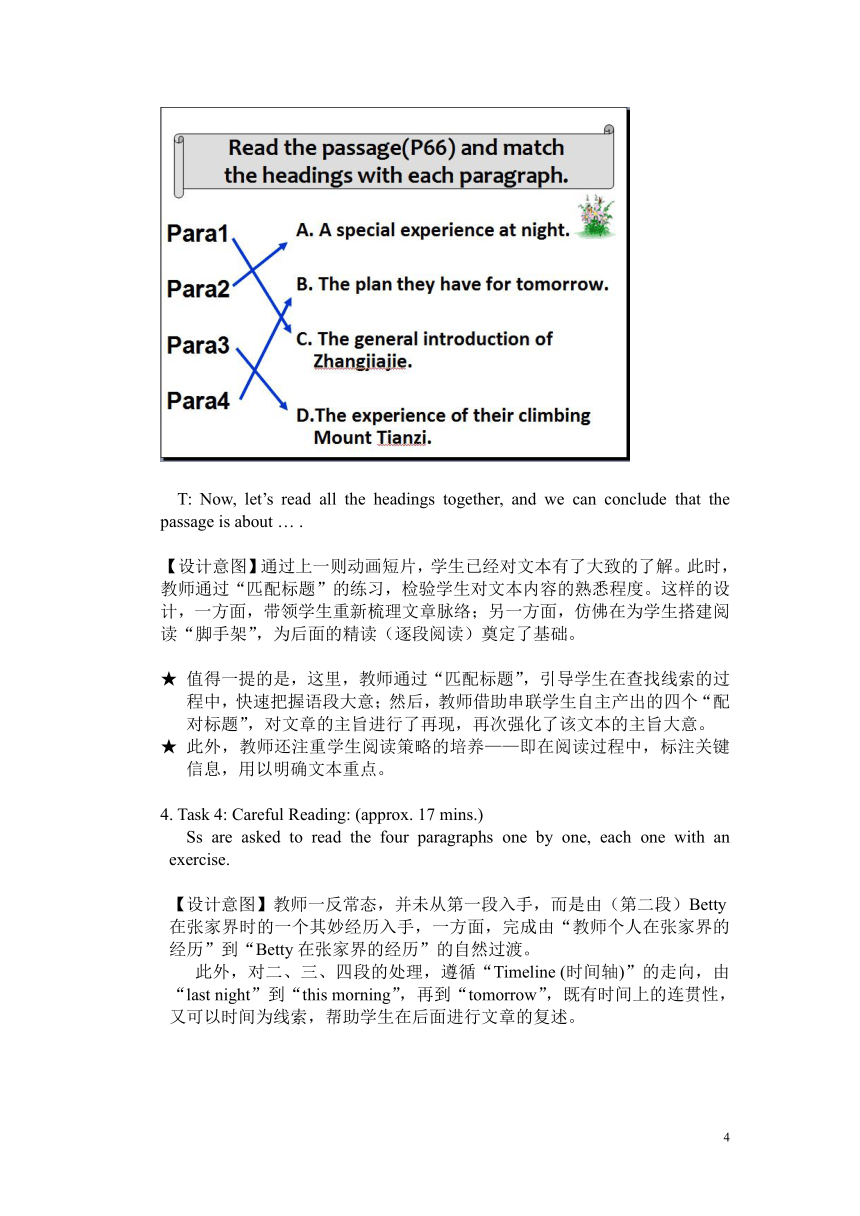外研版八年级下册英语 Module 8 Unit 2 We thought somebody was movg about 教案
文档属性
| 名称 | 外研版八年级下册英语 Module 8 Unit 2 We thought somebody was movg about 教案 |

|
|
| 格式 | doc | ||
| 文件大小 | 564.0KB | ||
| 资源类型 | 教案 | ||
| 版本资源 | 外研版 | ||
| 科目 | 英语 | ||
| 更新时间 | 2022-06-01 11:08:08 | ||
图片预览




文档简介
Lesson Plan for Module 8 Time off
Unit 2 We thought somebody was moving about.
I. Analysis of Teaching Material
The material of this lesson is for the second term, Grade 8 (FLTRP edition). It is the second unit of Module 8, named “We thought somebody was moving about”. In the previous two modules, the students have already learnt the use of simple sentences and composite sentences, which has laid a firm foundation for the students’ learning of this module. Thus, based on the teaching objectives of this module, the task we should emphasize and fulfill is teaching students how to read and write passages about the travelling experience.
II. Analysis of Students
The topic of this unit is “Tourism and Nature”. It’s a topic that most of the students are familiar with, which can be viewed as a two-edged sword. On the one hand, it can easily arouse students’ interest and background knowledge. While on the other, students may lose their interest if the material is not well designed. Besides, by reading the passage of Betty’s experience in Zhangjiajie, the students’ love of nature and the spirit of adventure will be cultivated.
III. Teaching Objectives
1. Knowledge Objectives
1.1 To be able to remember the key words: square, kilometer, shape, human, camp, path, pull, etc.
1.2 To be able to identify and use the key phrases: wake sb. up, move about, have a wonderful time, camp by, from the top, etc.
1.3 To be able to understand the key sentences: It’s a magic land of…, It’s famous for…, I hope that…, We thought (that)…, Lingling’s uncle said (that)…, etc.
2. Skill Objectives
2.1 To be able to talk about travelling experience with object clauses, such as “I think that…”, “I hope that…”, etc.
2.2 To be able to read for specific information and select the key points in the passage.
2.3 To be able to read and write a passage about one’s own travelling experience within 60 words.
3. Moral Objectives
The content of this period is about nature and tourism, which is closely related to students’ life, so it may easily arouse their interest. Moreover, by sharing their own opinions and experiences, it could also promote the emotional communication between teacher and students. Besides, the students’ activities in class will develop their spirit of team work through discussion and communication. Last but not the least, by reading the passage of Betty’s experience in Zhangjiajie, the students’ love of nature and the spirit of adventure will be cultivated.
IV. Key Points and Difficult Points
1. Key Points
To be able to understand and apply the new words such as “shape”, “human”, “square”, “kilometre” etc, and new phrases such as “have a wonderful time”, “camp by”, “from the top”, etc.
2. Difficult Points
To be able to know how to introduce their travelling experience properly with the object clauses.
V. Teaching Methods
1. Task-based Language Teaching
2. Interactive Approach
3. PPP Model
VI. Teaching Aids
Multi-media, pictures, etc.
VII. Teaching Procedure
(T: Teacher; S: Student)
1. Task 1: (approx. 5 mins.)
T shows Ss some pictures of famous sights in the world, and asks Ss what they are and where they are. (The Great Wall, Big Ben, Eiffel Tower…)
T: Here are some pictures of famous sights around the world, and do you know what they are and where they are
S1: I think that it is… . And I hope that… .
S2: ……
【设计意图】该环节的设计基于“行为主义”理论,通过呈现世界各地的不同风景名胜,引导学生多次使用本节课所要学习的宾语从句“I think that…”、“I hope that…”,在反复操练(刺激-强化)的过程中,帮助学生在头脑中构建新知。此外,通过激发学生对风景名胜的兴趣,为后文介绍张家界这一景点奠定了基础。
2. Task 2: (approx. 3 mins.)
T shares her own experience of traveling in Zhangjiajie with Ss.
T: Miss Zhu went to Zhangjiajie during the summer holiday. Do you want to know my experience in Zhangjiajie
Ss: Yes!
T: OK, let’s have a look.
【设计意图】教师先从自己的经历说起,激发学生的学习兴趣,再借用自身经历,直观呈现本节课新词汇,为学生营造“浸入式”的英语学习环境。
T: From the video, I think that Zhanjiajie is a magic land of… (Ss’ talking). And I hope that… (Ss’ talking).
【设计意图】教师再次运用宾语从句,引导学生根据刚才所看的视频进行复述,强化宾语从句的使用。
3. Task 3: Fast Reading (approx. 4 mins.)
Ss are asked to watch the video of the passage and match four headings with each paragraph. They are allowed to read after the recording.
T: Betty has also been to Zhangjiajie, and she wrote an email about her travelling experience. What did Betty write Let’s watch a video and see what she wrote to her parents.
【设计意图】教师通过分享自己在张家界的经历,学生已对张家界的自然风貌有了初步的了解。这时,通过Betty的邮件,引入她与朋友在张家界的见闻,再一次激发了学生的学习兴趣。
★ 值得一提的是,虽然本课主要为“读写课型”,但教师并没有直接带领学生进行阅读,而是选用动画短片,对语段内容进行直观呈现。这样的设计,一方面,通过调动学生的听觉和视觉,帮助学生快速熟悉文本的主要内容;另一方面,锻炼学生快速概括文章大意的能力。
Assessment 1: Ss are asked to match the headings with each paragraph. Every student need to find out the “clues” to prove that the heading they get can be matched to the corresponding paragraph. After the presentation, the teacher puts all the headings together, and helps Ss to retell the main idea of the passage.
T: Now, let’s read the passage in your book. Try to match each heading with one of the paragraphs. And 3 minutes later, we will need you to show the answer and the reason. You can underline the “clues” (words, phrases, or sentences) to help you.
T: Now, let’s read all the headings together, and we can conclude that the passage is about … .
【设计意图】通过上一则动画短片,学生已经对文本有了大致的了解。此时,教师通过“匹配标题”的练习,检验学生对文本内容的熟悉程度。这样的设计,一方面,带领学生重新梳理文章脉络;另一方面,仿佛在为学生搭建阅读“脚手架”,为后面的精读(逐段阅读)奠定了基础。
★ 值得一提的是,这里,教师通过“匹配标题”,引导学生在查找线索的过程中,快速把握语段大意;然后,教师借助串联学生自主产出的四个“配对标题”,对文章的主旨进行了再现,再次强化了该文本的主旨大意。
★ 此外,教师还注重学生阅读策略的培养——即在阅读过程中,标注关键信息,用以明确文本重点。
4. Task 4: Careful Reading: (approx. 17 mins.)
Ss are asked to read the four paragraphs one by one, each one with an exercise.
【设计意图】教师一反常态,并未从第一段入手,而是由(第二段)Betty在张家界时的一个其妙经历入手,一方面,完成由“教师个人在张家界的经历”到“Betty在张家界的经历”的自然过渡。
此外,对二、三、四段的处理,遵循“Timeline (时间轴)”的走向,由“last night”到“this morning”,再到“tomorrow”,既有时间上的连贯性,又可以时间为线索,帮助学生在后面进行文章的复述。
(Para. 2-read and find out the answers)
【设计意图】教师创设情境,引导学生猜测——是谁发出了声响?从而锻炼学生的想象力,激发其勇于探索的精神。此外,借助两个细节问题,教师激发学生的探究兴趣,有利于帮助学生快速定位细节信息。
(Para. 3-read and underline the answers)
【设计意图】学生带着3个问题朗读第三段,教师引导学生在思考和回答问题的过程中,对第三段内容抽丝剥茧。
在完成练习之后,基于本段最后几句话(…We should protect everything here.),稍作延伸,引出本节课的情感目标——我们应该保护大自然。
(Para. 4-read and find out the answers)
【设计意图】这段的处理,通过“tomorrow”和“next week”这两个关键词,引导学生善于根据不同的时间点,把握细节信息;此外,以树状图呈现,条理清晰。
Assessment2 : Retell Betty’s experience in Zhangjiajie accordint o the timeline.)
【设计意图】帮助学生以时间作为主线,对文章进行复述,同时将有利于学生由“输入”向“输出”的转换。
(Para. 1-read and fill in the blanks)
【设计意图】第一段对张家界的描述,可通过左列的问题进行细化、分解,找出对应答案的同时,也有利于学生从结构上梳理——如何描写某地景色,完成由“输入”向“输出”的转换。
5. Task 5: (approx. 8 mins.)
Ss are asked to introduce the Yellow Mountain or Lu Mountain to their partners.
【设计意图】本环节的设置,不拘泥于单纯的文本教学,引导学生关注如何利用关键词进行景点的描述。此外,共设置了2个不同的景点(黄山/庐山),在一定程度上给学生自由发挥的空间,培养学生在真实环境中运用英文的能力。
6. Summary (approx. 3 mins.)
【设计意图】本环节的设置,为学生再现本节课的重难点,帮助学生明确需要重点掌握的词汇与技能。
7. Homework
【设计意图】基于“人本主义”相关理论,教师在制定作业的同时,提供给学生相应的网站资源,帮助不同学能的学生选择自己需要的学习资料。
8. Teaching Reflection
To be written immediately after class.
VIII. Chalkboard Design
IX. The Reflection of the Instructional Design
The presentation of this lesson is aimed to help students know how to differentiate the different tenses in the object clauses, and how to talk about and write a passage about their travelling experience appropriately with object clauses, such as “We thought (that)…”, etc. The whole process of teaching and learning is organized with several tasks, which is based on TBL (Task-based Learning). From the very beginning of the passage, the teacher tries to use several pictures and videos to arouse students’ interest of learning. And then, the teacher adds different kinds of activities (jigsaw reading, matching the headings to the paragraphs, etc.) to cultivate students’ interest and motivation. Besides, the teacher not only focuses on the language points, but also on the overall abilities of language use, including the ability of reading, writing, listening, speaking, and on how to start and end emails. Moreover, according to Krashen’s Affective Filter Hypothesis, students are more willing to learn with confidence. Therefore, students’ autonomous learning ability is emphasized during teaching and learning. Generally speaking, this lesson tends to be learner-centred.
Module 8 Time off
Unit 2 We thought somebody was moving about.
1. Words: sights, shape, path, square, kilometer, etc.
2. Phrases: have a wonderful time, camp by, from the top, etc.
3. Sentences: It’s a magic land of…
It’s famous for…
I hope that…,
We thought (that)…,
Lingling’s uncle said (that)…, etc.
☆ how to introduce a place:
1. Where is it
2. How large is it
3. What is it famous for
…… ……
PAGE
6
Unit 2 We thought somebody was moving about.
I. Analysis of Teaching Material
The material of this lesson is for the second term, Grade 8 (FLTRP edition). It is the second unit of Module 8, named “We thought somebody was moving about”. In the previous two modules, the students have already learnt the use of simple sentences and composite sentences, which has laid a firm foundation for the students’ learning of this module. Thus, based on the teaching objectives of this module, the task we should emphasize and fulfill is teaching students how to read and write passages about the travelling experience.
II. Analysis of Students
The topic of this unit is “Tourism and Nature”. It’s a topic that most of the students are familiar with, which can be viewed as a two-edged sword. On the one hand, it can easily arouse students’ interest and background knowledge. While on the other, students may lose their interest if the material is not well designed. Besides, by reading the passage of Betty’s experience in Zhangjiajie, the students’ love of nature and the spirit of adventure will be cultivated.
III. Teaching Objectives
1. Knowledge Objectives
1.1 To be able to remember the key words: square, kilometer, shape, human, camp, path, pull, etc.
1.2 To be able to identify and use the key phrases: wake sb. up, move about, have a wonderful time, camp by, from the top, etc.
1.3 To be able to understand the key sentences: It’s a magic land of…, It’s famous for…, I hope that…, We thought (that)…, Lingling’s uncle said (that)…, etc.
2. Skill Objectives
2.1 To be able to talk about travelling experience with object clauses, such as “I think that…”, “I hope that…”, etc.
2.2 To be able to read for specific information and select the key points in the passage.
2.3 To be able to read and write a passage about one’s own travelling experience within 60 words.
3. Moral Objectives
The content of this period is about nature and tourism, which is closely related to students’ life, so it may easily arouse their interest. Moreover, by sharing their own opinions and experiences, it could also promote the emotional communication between teacher and students. Besides, the students’ activities in class will develop their spirit of team work through discussion and communication. Last but not the least, by reading the passage of Betty’s experience in Zhangjiajie, the students’ love of nature and the spirit of adventure will be cultivated.
IV. Key Points and Difficult Points
1. Key Points
To be able to understand and apply the new words such as “shape”, “human”, “square”, “kilometre” etc, and new phrases such as “have a wonderful time”, “camp by”, “from the top”, etc.
2. Difficult Points
To be able to know how to introduce their travelling experience properly with the object clauses.
V. Teaching Methods
1. Task-based Language Teaching
2. Interactive Approach
3. PPP Model
VI. Teaching Aids
Multi-media, pictures, etc.
VII. Teaching Procedure
(T: Teacher; S: Student)
1. Task 1: (approx. 5 mins.)
T shows Ss some pictures of famous sights in the world, and asks Ss what they are and where they are. (The Great Wall, Big Ben, Eiffel Tower…)
T: Here are some pictures of famous sights around the world, and do you know what they are and where they are
S1: I think that it is… . And I hope that… .
S2: ……
【设计意图】该环节的设计基于“行为主义”理论,通过呈现世界各地的不同风景名胜,引导学生多次使用本节课所要学习的宾语从句“I think that…”、“I hope that…”,在反复操练(刺激-强化)的过程中,帮助学生在头脑中构建新知。此外,通过激发学生对风景名胜的兴趣,为后文介绍张家界这一景点奠定了基础。
2. Task 2: (approx. 3 mins.)
T shares her own experience of traveling in Zhangjiajie with Ss.
T: Miss Zhu went to Zhangjiajie during the summer holiday. Do you want to know my experience in Zhangjiajie
Ss: Yes!
T: OK, let’s have a look.
【设计意图】教师先从自己的经历说起,激发学生的学习兴趣,再借用自身经历,直观呈现本节课新词汇,为学生营造“浸入式”的英语学习环境。
T: From the video, I think that Zhanjiajie is a magic land of… (Ss’ talking). And I hope that… (Ss’ talking).
【设计意图】教师再次运用宾语从句,引导学生根据刚才所看的视频进行复述,强化宾语从句的使用。
3. Task 3: Fast Reading (approx. 4 mins.)
Ss are asked to watch the video of the passage and match four headings with each paragraph. They are allowed to read after the recording.
T: Betty has also been to Zhangjiajie, and she wrote an email about her travelling experience. What did Betty write Let’s watch a video and see what she wrote to her parents.
【设计意图】教师通过分享自己在张家界的经历,学生已对张家界的自然风貌有了初步的了解。这时,通过Betty的邮件,引入她与朋友在张家界的见闻,再一次激发了学生的学习兴趣。
★ 值得一提的是,虽然本课主要为“读写课型”,但教师并没有直接带领学生进行阅读,而是选用动画短片,对语段内容进行直观呈现。这样的设计,一方面,通过调动学生的听觉和视觉,帮助学生快速熟悉文本的主要内容;另一方面,锻炼学生快速概括文章大意的能力。
Assessment 1: Ss are asked to match the headings with each paragraph. Every student need to find out the “clues” to prove that the heading they get can be matched to the corresponding paragraph. After the presentation, the teacher puts all the headings together, and helps Ss to retell the main idea of the passage.
T: Now, let’s read the passage in your book. Try to match each heading with one of the paragraphs. And 3 minutes later, we will need you to show the answer and the reason. You can underline the “clues” (words, phrases, or sentences) to help you.
T: Now, let’s read all the headings together, and we can conclude that the passage is about … .
【设计意图】通过上一则动画短片,学生已经对文本有了大致的了解。此时,教师通过“匹配标题”的练习,检验学生对文本内容的熟悉程度。这样的设计,一方面,带领学生重新梳理文章脉络;另一方面,仿佛在为学生搭建阅读“脚手架”,为后面的精读(逐段阅读)奠定了基础。
★ 值得一提的是,这里,教师通过“匹配标题”,引导学生在查找线索的过程中,快速把握语段大意;然后,教师借助串联学生自主产出的四个“配对标题”,对文章的主旨进行了再现,再次强化了该文本的主旨大意。
★ 此外,教师还注重学生阅读策略的培养——即在阅读过程中,标注关键信息,用以明确文本重点。
4. Task 4: Careful Reading: (approx. 17 mins.)
Ss are asked to read the four paragraphs one by one, each one with an exercise.
【设计意图】教师一反常态,并未从第一段入手,而是由(第二段)Betty在张家界时的一个其妙经历入手,一方面,完成由“教师个人在张家界的经历”到“Betty在张家界的经历”的自然过渡。
此外,对二、三、四段的处理,遵循“Timeline (时间轴)”的走向,由“last night”到“this morning”,再到“tomorrow”,既有时间上的连贯性,又可以时间为线索,帮助学生在后面进行文章的复述。
(Para. 2-read and find out the answers)
【设计意图】教师创设情境,引导学生猜测——是谁发出了声响?从而锻炼学生的想象力,激发其勇于探索的精神。此外,借助两个细节问题,教师激发学生的探究兴趣,有利于帮助学生快速定位细节信息。
(Para. 3-read and underline the answers)
【设计意图】学生带着3个问题朗读第三段,教师引导学生在思考和回答问题的过程中,对第三段内容抽丝剥茧。
在完成练习之后,基于本段最后几句话(…We should protect everything here.),稍作延伸,引出本节课的情感目标——我们应该保护大自然。
(Para. 4-read and find out the answers)
【设计意图】这段的处理,通过“tomorrow”和“next week”这两个关键词,引导学生善于根据不同的时间点,把握细节信息;此外,以树状图呈现,条理清晰。
Assessment2 : Retell Betty’s experience in Zhangjiajie accordint o the timeline.)
【设计意图】帮助学生以时间作为主线,对文章进行复述,同时将有利于学生由“输入”向“输出”的转换。
(Para. 1-read and fill in the blanks)
【设计意图】第一段对张家界的描述,可通过左列的问题进行细化、分解,找出对应答案的同时,也有利于学生从结构上梳理——如何描写某地景色,完成由“输入”向“输出”的转换。
5. Task 5: (approx. 8 mins.)
Ss are asked to introduce the Yellow Mountain or Lu Mountain to their partners.
【设计意图】本环节的设置,不拘泥于单纯的文本教学,引导学生关注如何利用关键词进行景点的描述。此外,共设置了2个不同的景点(黄山/庐山),在一定程度上给学生自由发挥的空间,培养学生在真实环境中运用英文的能力。
6. Summary (approx. 3 mins.)
【设计意图】本环节的设置,为学生再现本节课的重难点,帮助学生明确需要重点掌握的词汇与技能。
7. Homework
【设计意图】基于“人本主义”相关理论,教师在制定作业的同时,提供给学生相应的网站资源,帮助不同学能的学生选择自己需要的学习资料。
8. Teaching Reflection
To be written immediately after class.
VIII. Chalkboard Design
IX. The Reflection of the Instructional Design
The presentation of this lesson is aimed to help students know how to differentiate the different tenses in the object clauses, and how to talk about and write a passage about their travelling experience appropriately with object clauses, such as “We thought (that)…”, etc. The whole process of teaching and learning is organized with several tasks, which is based on TBL (Task-based Learning). From the very beginning of the passage, the teacher tries to use several pictures and videos to arouse students’ interest of learning. And then, the teacher adds different kinds of activities (jigsaw reading, matching the headings to the paragraphs, etc.) to cultivate students’ interest and motivation. Besides, the teacher not only focuses on the language points, but also on the overall abilities of language use, including the ability of reading, writing, listening, speaking, and on how to start and end emails. Moreover, according to Krashen’s Affective Filter Hypothesis, students are more willing to learn with confidence. Therefore, students’ autonomous learning ability is emphasized during teaching and learning. Generally speaking, this lesson tends to be learner-centred.
Module 8 Time off
Unit 2 We thought somebody was moving about.
1. Words: sights, shape, path, square, kilometer, etc.
2. Phrases: have a wonderful time, camp by, from the top, etc.
3. Sentences: It’s a magic land of…
It’s famous for…
I hope that…,
We thought (that)…,
Lingling’s uncle said (that)…, etc.
☆ how to introduce a place:
1. Where is it
2. How large is it
3. What is it famous for
…… ……
PAGE
6
同课章节目录
- Module 1 Feelings and impressions
- Unit 1 It smells delicious.
- Unit 2 I feel nervous when I speak Chinese .
- Unit 3 Language in use
- Module 2 Experiences
- Unit 1 I've also entered lots of speaking competi
- Unit 2 They have seen the Pyramids.
- Unit 3 Language in use
- Module 3 Journey to space
- Unit 1 Has it arrived yet?
- Unit 2 We have not found life on any other planet
- Unit 3 Language in use
- Module 4 Seeing the docto
- Unit 1 I haven't done much exercise since I got m
- Unit 2 We have played football for a year now
- Unit 3 Language in use
- Module 5 Cartoons
- Unit 1 It's time to watch a cartoon.
- Unit 2 Tintin has been popular for over eighty yea
- Unit 3 Language in use
- Revision module A
- Module 6 Hobbies
- Unit 1 Do you collect anything ?
- Unit 2 Hobbies can make you grow as a person.
- Unit 3 Language in use
- Module 7 Summer in Los Angeles
- Unit 1 Please write to me and send me some photos
- Unit 2 Fill out a form and come to learn English
- Unit 3 Language in use
- Module 8 Time off
- Unit 1 I can hardly believe we are in the city ce
- Unit 2 We thought somebody was moving about
- Unit 3 Language in use
- Module 9 Friendship
- Unit 1 Could I ask if you've mentioned this to he
- Unit 2 I believe that the world is what you think
- Unit 3 Language in use
- Module 10 On the radio
- Unit 1 I hope that you can join us one day
- Unit 2 It seemed that they were speaking to me in
- Unit 3 Language in use
- Revision module B
